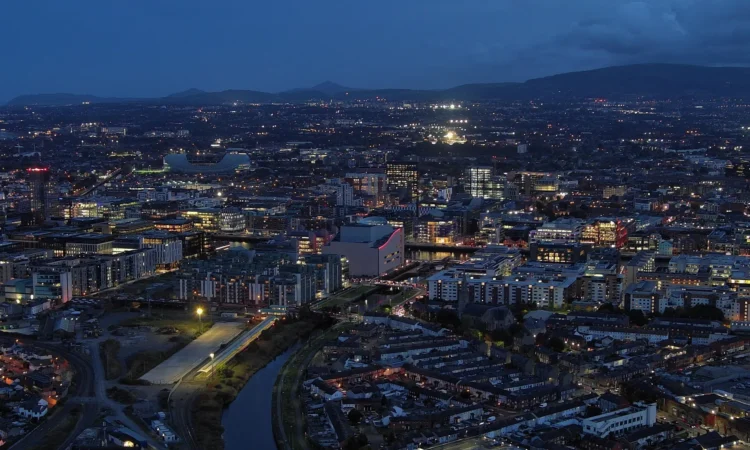
The city’s vacancy rate has doubled in the last six years, exceeding the 10% reached in Paris and 8% in London and Lisbon
A PARTIALLY empty, five-story building close to the old Guinness family home in Dublin’s city centre offers a glimpse into the slowdown gripping parts of the Irish capital’s office market.
The owner, Blackstone Inc, is in talks to hand back the keys to 75 St Stephen’s Green, which it bought in 2019 as part of a wider portfolio, to its lenders.
“These assets were prudently written down to zero some time ago, given the well-documented headwinds facing the Irish office market,” Blackstone said in response to questions. “These are extremely rare instances in our US$600 billion global portfolio where our office exposure remains minimal.”
Blackstone joins investors including Brookfield Asset Management and Henderson Park in seeing bets on Dublin’s tech-heavy office market sour. After the pandemic hit, demand slumped just as supply surged, and the city now has one of the highest vacancy rates in Europe at more than 17 per cent. Worse may be ahead.
“Dublin offices seemed like a good bet because of the city’s track record of attracting and retaining US tech sector investment,” John McCartney, real estate lecturer at Technological University Dublin, said. “As vacancy shifts to older buildings, their owners will be forced to cut rents, and this could trigger some counter-cutting.”
Across Europe, the end of the low-interest-rate era sent property values plummeting as prices readjusted to reflect the higher rates of return available elsewhere. In many cities, limited development and robust tenant demand have partially offset that pain, as scant vacancy for the best new space has forced rents higher. That’s softened the hit to values, which are a function of both the rent a building generates and the multiple of that rent investors are willing to pay.
BT in your inbox

Start and end each day with the latest news stories and analyses delivered straight to your inbox.
But Dublin’s vacancy rate has doubled in the last six years, exceeding the 10 per cent reached in Paris and 8 per cent in London and Lisbon, for example, according to broker CBRE Group. Much of that increase is visible in empty suburban offices, though prime rents have still dropped about 11 per cent since 2022, Knight Frank figures show.
That has precipitated a dramatic drop-off in new development that may lead to rents rising in the future, but it’s little comfort to the private equity firms that bet on the Irish capital in the latter part of the low interest rate era. With valuations falling and loans coming due, an anticipated rebound hasn’t protected them from the pain.
Combined, Blackstone, Brookfield and Henderson Park invested at least five billion euros (S$7.5 billion) of debt and equity in the city’s offices between 2019 and 2022.
What’s gone wrong
After the pandemic, Dublin office completions surged, with well over 200,000 square meters of new space delivered in 2022, the most in the past decade, according to data compiled by CBRE. But that was followed by a major slowdown in office leasing, with the take-up of new office space dropping more than 45 per cent in 2023 and remaining below the long-term average since, the broker’s data showed.
The amount of so-called gray space – offices that are leased but not occupied – also increased sharply and put more pressure on landlords looking for tenants.
“Dublin had excessive supply growth over the last decade,” said Mitchell Briggs, analyst at Green Street Advisors.
Blackstone burned
Some were caught off guard. Blackstone paid Starwood Capital Group 535 million euros for the so-called Cedar portfolio, which includes the St Stephen’s Green property. Starwood provided a mezzanine loan, while Pacific Investment Management provided the senior debt.
It has since sold off parts of the portfolio, but the remaining 92 million euros of equity has been written off, according to a person with knowledge of the write-down. Blackstone is handing back the keys in the process of a consensual handover, the person said, asking not to be identified discussing confidential information.
Talks are ongoing and they could still agree a restructuring, the person said. A representative for Blackstone declined to comment on the size of the write-off.
Blackstone maintains this is a rare misstep. Including Cedar, the firm bought or financed about three billion euros of Dublin real estate, buying offices let to companies including Meta Platforms and Amazon.com.
“Our Irish office portfolio is concentrated in high-quality, newly built assets attracting long-term blue-chip tenants,” it said. “While short-term volatility may persist, Dublin’s office market is well-positioned for the long-term.”
Not just Blackstone
A Blackstone mortgage trust also financed private equity firm Henderson Park’s foray into the Dublin office market, providing a 1.2-billion-euro loan for the takeover of Green Reit in 2019. Founded by former Goldman Sachs partner Nick Weber, Henderson Park bought the property firm for 1.34 billion euros.
Since then, Henderson Park has written down the value of properties in HPREF Dublin Office Bidco Limited, the entity which took Green Reit private, by 271.6 million euros. It has also recorded a cumulative loss of 347 million euros.
The portfolio has been rebalanced towards industrial and logistics facilities, Henderson Park said. Still, some offices remain in the portfolio, with Vodafone Group set to leave Central Park in the south of the city, leaving Henderson Park with even more space to fill. At least 200,000 square feet is available, according to the Central Park website.
“Central Park is going through a natural leasing cycle and remains the No 1 destination in Dublin’s suburban office market,” the firm said. “Our offices have performed throughout our ownership.”
Brookfield too
Brookfield was also among the bidders for Green Reit when it was put up for sale. After losing out to Henderson Park in 2019, it eventually made its move in the summer of 2022, taking rival Hibernia Reit private for 1.1 billion euros just as the European Central Bank began its hiking cycle.
Since then, it has written down the value of the properties by 250 million euros, filings show. The alternative asset manager recently secured a refinancing of the debt secured against Hibernia, replacing the 900 million facility euros it used to buy the Reit in 2022 with 700 million euros of debt.
Brookfield too remains upbeat.
“Hibernia’s portfolio of high-quality, well-located assets benefits from 98 per cent occupancy and a diversified tenant base,” the firm said.
And some optimism is emerging. The third quarter of 2025 saw the strongest quarter of take-up in over a year and there are signs that rents are again starting to rise, according to data compiled by CBRE.
Still, last month, Irish builder Glenveagh Properties said it might be 2028 before its Freight Building in Dublin’s north docks is fully occupied and ready for sale.
Back at 75 St Stephen’s Green, talks to lease space in the building to existing tenant, legal firm Maples Group, are at an advanced stage. For now, though, a sign plastered on the glass front window still advertises 14,400 sq ft of space at one of the city’s “premier” addresses. BLOOMBERG






